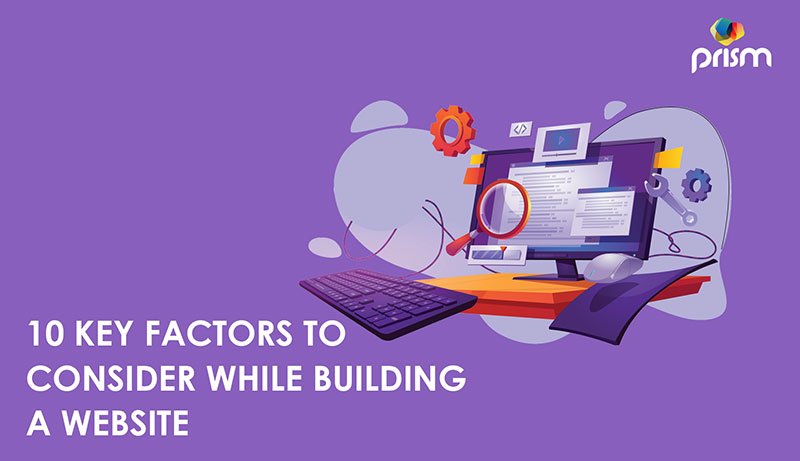

Building a Successful Website: 10 Critical Factors to Keep in Check

Table Of Contents
- Why should you clarify the objectives before developing a website?
- Why is it important to build your audience’s trust?
- How to define your budget for web development?
- How to create a website that stands out among the rest?
- Why is user experience important in web development?
- How to optimize landing pages?
- Why is it important to use analytics for your website?
- What is heat mapping?
- How to make sure your website works perfectly?
1. Define Your Objectives Clearly
The key is to start any web or marketing project with clear goals and consider both the search engines as well as the users while devising a plan.
Only by ensuring that we have what our target audience wants and can give it to them in a reasonable manner will the site create traffic, leads, and sales.
It is quite simple most of the time, but it can get a bit tricky to define the objectives that you want to achieve and the value that the users will be getting.
If your goals aren't well defined, you'll likely run into a scenario where you want to earn money but can't give the product and experience your audience wants.
It's frustrating to put time and money on a website only to discover that users are bouncing away and that no one knows why they should buy from you. This is a strong indicator that you were overly focused on your own end objectives rather than the users.
This is why it is important to bring much-needed clarity when it comes to goals and objectives. Web development companies put a lot of emphasis on clarifying goals before starting the development process.
2. Earn the Trust of Your Audience
It is important to build your audience’s trust and the first thing that comes to mind when we talk about trust is transparency. Be very clear about what your offerings are and what action you want users to take.
Know what the audience wants and act on that. Moreover, understand what you’re strong points are and leverage those. Most of the time websites lack credibility and that hinders the sales process. If your website lacks the emotional appeal and trust factor, you are less likely to achieve your objectives.
Users want to know who they're dealing with, not just that you're another commodity website in the sector. You won't be able to send across a clear image of what your brand is about if you can't include people, visuals, culture, philosophy, or some form of the tale on your website.
Even budget-conscious consumers who are just seeking for the best deals want to have a significant amount of confidence in your legitimacy before entering their credit card information.
The bottom line is that it is imperative for you to focus on building trust and credibility if you want your brand to thrive.
3. Budget Properly
Prepare to put money into your online presence and make sure to do it wisely. Budgeting should be done keeping all the aspects in check. Many of the companies overspend on their websites and then cut corners on marketing.
On the other hand, some people want to spend a lot of money on marketing but won't invest anything into their website.
Spend wisely by choosing the right tools and platforms that compliment your offerings. For example, choose the right CMS and technology that suits your needs and that is in line with what the users expect.
This will help you achieve your objectives efficiently and you won’t have to scrap ideas and start over just to get to the same point.
Know the limitations and advantages of the platform you're going to use. That way you will know how much you are spending and that you’re spending in the right areas.
It is possible to have a bespoke design and/or custom code. However, make sure it's not excessive, and that it doesn't push your breakeven point too far.
Don't do too much or too little. To make the best decisions, you need to know what your upfront investment is and how much you can stretch it depending on the advantage.
4. Find Ways to Stand Out Among the Crowd
The key is differentiation, but it doesn’t mean that you have to do something out of ordinary. You can use a template and still look different and unique. You can stand out by using top-notch imagery and styles.
When you tell your narrative and include elements such as pricing, quality, customer service, what you do with revenues, how you give back, and so on, you build the relationship necessary to differentiate yourself from the other templated and rapidly spun-up sites selling the same items or services.
It doesn’t really matter how you are doing it, but the key is to add a differentiating factor that compels customers to do business with you rather than others in the market with similar prices.
5. Focus on Usability & User Experience
User experience is the primary factor when it comes to web development. Focus on making it simpler and easier for users to find what you want them to find. Make it easy for them to find content by mapping the website strategically.
If you provide items or services, ensure that customers can get to the target page with the fewest number of clicks.
Consider the positioning of your search box and other clues strategically that lead to valuable content, in addition to having straightforward main menu navigation designed for mobile and desktop users.
6. optimize landing pages?
Landing pages are an effective tool for different kinds of campaigns including PPC, email marketing, inbound marketing, etc.
If you're conducting any kind of marketing, you'll need a system that allows you to quickly create and customize landing pages.
If you're utilizing these pages for dedicated campaigns outside of accessible, standard website material, make sure your website or content management system provides you control and allows you to adjust indexing status, adjust navigation, and split these pages from the typical navigation pathways.
7. Use Analytics
It goes without saying how important is Google Analytics for your website. Set the analytics up because you need that vital information about the demographics of users, goal completions, and much more. The information you won’t be able to gather if you don’t have the analytics set up.
Only setting it up and forgetting about it won’t help. You don’t even have to sign into Google Analytics everyday to get valuable information. You can set up reports and alerts so that you can stay on top of everything and you have a basic idea of what’s working and what’s not for the website.
8. Learn from Heat Mapping
Heat mapping and other user analytics provide much-needed additional information about users and user experience. UX-related factors are most critical for website success.
There are tools such as lucky Orange, etc. that give you data about the user’s mouse movement, how much of the form they've filled before bouncing, etc. Moreover, it can also give you insights about where users are getting stuck and a lot more.
These insights could give you an idea about the user’s behavior so that you can plan accordingly.
10. Make Sure Your Website Works Perfectly
Load time is what we look at when it comes to a website working fine. However, it is much more than just that. You might be focused on user data, sales, and much more and you might miss the details such as some buttons not working, mobile experience issues, or browser-specific bugs without specific protocols in place.
This means that you might be missing out on different opportunities because your potential customers are getting stuck and facing roadblocks. Users won’t contact you if they can’t buy or can’t use your services, the chances are that they will just bounce away.
To deal with this issue, make sure that there are set protocols in place to notify you if any issues arrive. Moreover, when you make any changes to the functionality, be sure to check that everything is working fine and nothing is broken as a result of those changes.
This will lower the bounce rate because of functionality errors, eventually increasing potential conversions.
This is it for today’s blog. I hope you liked it. Be sure to share your feedback with us in the comments section. If you have any questions or queries, reach out to me and I’ll get back to you as soon as possible. Prism, the Best Web Development Agency in Dubai provides top-notch web development services. If you want to build a website for your business, Contact Prism and we’ll take care of the rest. Thank you and Goodbye.
How to make sure your website works perfectly?

About The Author: Lovetto Nazareth
Lovetto Nazareth is a digital marketing consultant and agency owner of Prism Digital. He has been in the advertising and digital marketing business for the last 2 decades and has managed thousands of campaigns and generated millions of dollars of new leads. He is an avid adventure sports enthusiast and a singer-songwriter. Follow him on social media on @Lovetto Nazareth
Post Your Comment!
Recent Blogs
Dominate Search Engines with Top-Tier PPC Management Dubai in 2025
Top Video Production Companies in Dubai – 2025
Mobile-First Indexing: How To Optimize Your Website For The Future
How do Dubai Digital Marketing Agencies Help Their Clients?

Support
Phone: +971 55 850 0095
Email: sales@prism.com
Location: Prism Digital Marketing Management LLC Latifa Tower, Office No. 604 - West Wing World Trade Center 1, Sheikh Zayed Road Dubai, UAE
Subscribe
Join our newsletter to stay up to date on features and releases.
By subscribing you agree to our Privacy Policy and provide consent to receive updates from our company.
